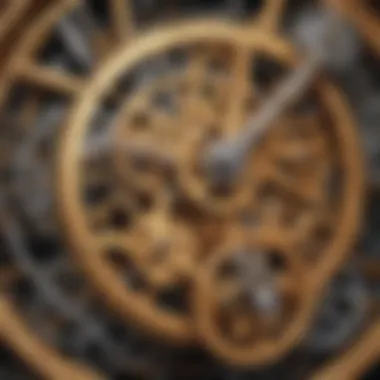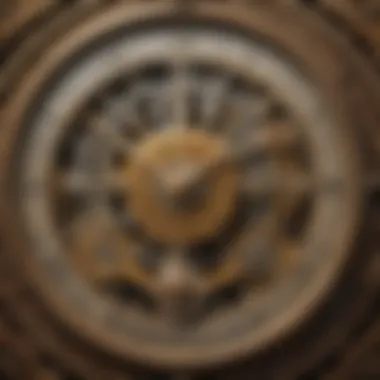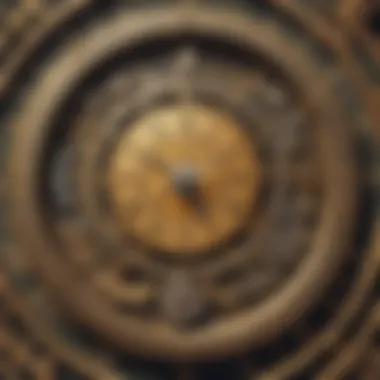Understanding the Functionality and Importance of Mechanical Clocks


Intro
Mechanical clocks with moving hands have fascinated humanity for centuries. These timepieces combine mechanics, craftsmanship, and art, making them more than just tools for telling time. Understanding how they work brings insight into not only their historical significance but tambien the cultural contexts they occupy.
As we embark on this exploration, we will consider the significant roles these clocks play in daily life. We will evaluate their innovative mechanisms, historical backgrounds, and artistic merits. This comprehensive guide aims to articulate the value of these intricate devices, appealing to both young learners and adults interested in history, art, and technology.
Creative Activities
Mechanical clocks can inspire creativity, especially among children. To engage young minds, here are some craft ideas that parents and caregivers can explore together.
Craft Ideas
- DIY Paper Clock: Children can cut out clock faces from colored paper and use brads for hands. This simple activity educates about clock anatomy.
- Designing Clock Faces: Encourage kids to design their unique clock faces. They may like to use various materials like paint, markers, or stickers.
Step-by-Step Guides
- Making a DIY Paper Clock:
- Creating Clock Faces:
- Materials: Colored paper, brads, stick glue, scissors, and markers.
- Cut one circle for the clock face and one long piece for each hand.
- Mark numbers from 1 to 12 on the face.
- Attach the hour and minute hands at the center with brads.
- Use blank templates or draw circles on poster board.
- Decorate the clock face using any materials available, encouraging playful designs.
Educational Value
These activities serve not just as fun crafts, but also enhance skills such as counting and telling time. In turn, creative expression flourishes as children learn about mechanics through hands-on engagement.
Fun Quizzes
Engagement with the topic can continue through quizzes. Quizzes serve as another method for reinforcing learning.
Quiz Topics
Kids can be quizzed on:
- History of clocks
- Mechanisms involved in clock movement
- Famous types of clocks
Question Types
To make quizzes engaging, various types of questions can be considered, like:
- Multiple-choice: Choose correct answers from presented options.
- True/False: Determine the validity of statements regarding clocks.
- Short answer: Provide brief explanations on clock functions.
Knowledge Reinforcement
Quizzes officially enable children to review what they learned while making learning fun. Through correct and incorrect answers, kids find areas needing more exploration.
Fact-Based Articles
Fact-based articles serve to position audience interests into deeper contexts regarding clocks. These articles present information in accessible yet informative manners.
Topics
Some diverse topics could include:
- The evolution of mechanical clocks
- Famous clockmakers and their contributions
- Advances in clock technology through centuries
Engaging Content
Content will be structured clearly and deliver factual accounts engagingly through formats like lists and key details. This make understanding better.
Prolusion to Mechanical Clocks
Understanding the concept of mechanical clocks is essential for grasping how time has been measured and perceived across various cultures and ages. Mechanical clocks, with their fascinating mechanisms, bridge art and science while captivating enthusiasts and casual observers alike. This introduction sheds light on several important aspects of mechanical clocks.


Their function transcends basic timekeeping; these clocks symbolize a historical journey, revealing technological advances and cultural shifts. Recognizing the unique nature of these devices offers respect towards craftsmanship and representation of human achievement.
In essence, mechanical clocks act as artifacts that connect us to our past while influencing modern design and technology in countless ways. To navigate our discussion, the next segments will interrogate the definition, overview, and historical context of mechanical clocks as we explore their complexities and importance.
Definition and Overview
A mechanical clock is a device designed to chronicle time through distinct components working with precision. Unlike digital counterparts, these clocks rely on physical mechanisms. Various parts such as gears, springs, and an escapement mechanism work cohesively to indicate time through moving hands. This design creates a physical representation of time's passage, offering both aesthetic charm and functionality.
Mechanical clocks often come in many styles, sizes, and complexities. They are available as wall clocks, table clocks, and other forms like grandfather clocks, each presenting unique artistic features. The hands used to show hours, minutes or seconds add to the charm, visually demonstrating the passage of time. An understanding of these individual elements lays the groundwork for appreciating the advanced mechanics that underscore their operation.
Historical Context
The origins of clockmaking date back to ancient civilizations, where timekeeping was paramount to agricultural practices and daily life routines. Early devices, such as sundials and water clocks, demonstrated the human effort to quantify time.
As societies evolved and technology advanced, mechanical clocks emerged in Europe around the 14th century. The invention of the escapement mechanism by craftsmen provided a significant leap in accuracy. These pioneers laid the foundations for horology, the art of measuring time. Some key historical insights include:
- 14th century: Introduction of progressive clock mechanisms.
- 17th century: Development of the pendulum clock by Christiaan Huygens, crucial for precision improvements.
- 18th and 19th centuries: Emergence of mass-produced clocks affecting social life widely.
Ultimately, the evolution of mechanical clocks reflects broader historical narratives, technological advancements, and cultural milestones tracing humanity’s journey through time.
The Mechanics Behind Clock Movement
Understanding the mechanics behind clock movement is essential to appreciate the intricate functioning of mechanical clocks. The processes that drive the movements of clock hands are quite fascinating and showcase the convergence of art and engineering. A deeper awareness of how various components interact helps in grasping the delicate balance between precision and aesthetic design in mechanical timepieces.
Clock Components
Gear System
The gear system is fundamental in a mechanical clock. It consists of multiple interconnected gears that convert energy from the power source into motion. This transformation is what propels the clock hands around the dial. A key characteristic of the gear system is its ability to amplify force while maintaining a smooth motion, ensuring accurate timekeeping. The design makes it a beneficial aspect for this article as it highlights how simple interactions can yield complex results.
A unique feature of the gear system lies in its adjustment capabilities. This flexibility allows for fine-tuning which contributes to the performance and longevity of the clock. However, a disadvantage may include the requirement of regular maintenance, as wear and tear can affect the accuracy over time. It is crucial for enthusiasts to acknowledge that the gear system's longevity is tied closely to its maintenance cycle.
Escapement Mechanism
The escapement mechanism is another vital component of mechanical clocks. It controls the release of energy from the gear train to the clock hands. This regulation of speed is what ultimately governs accuracy. A defining characteristic of the escapement mechanism is its ability to create a rhythmic action that ensures steady movement of the hands. Its pivotal role in synchronizing the clock also demands attention, as it reflects the careful craftsmanship involved.
One unique feature of this mechanism is the increasing range of innovative designs, such as the Pallet Escapement. These designs provide improved accuracy, showcasing advances in horological engineering. One potential downside is its vulnerability to disturbances; if misaligned, even minute changes can lead to significant time inaccuracies.
Power Source
The power source serves as the heart of any mechanical clock, providing the energy required for operation. The traditional spring mechanism is most often found in these types of clocks. A notable characteristic of this spring-powered design includes its ability to store energy effectively. This design enables consistent power release as the clock operates throughout the day.
One unique feature is the option of using weights instead of springs in some designs. Weights can provide a more extended winding period, improving longevity. However, the need for regular winding of spring-powered clocks can be viewed as a disadvantage. This maintenance requirement demonstrates the balance between operation and upkeep again seen in clock mechanics.
Types of Movements
Quartz Movement
Quartz movement represents a shift in clock technology. Utilizing a quartz crystal's ability to vibrate at a consistent frequency, quartz watches accurately measure time while being more affordable to produce. A key characteristic is the remarkable precision and minimal maintenance required. These features make quartz movement a popular choice for everyday timepieces.
One unique aspect is the battery requirement, as it naturally limits a collector's options for repair and alteration. While quartz clocks require significantly less attention over time, the battery change can sometimes be overlooked, resulting in unexpected downtime.
Mechanical Movement
Mechanical movement sets a charming contrast to quartz systems. These movements rely entirely on physical components and manual winding to retain precision. This traditional approach often appeals to enthusiasts drawn to craftsmanship. A prominent characteristic of mechanical watches includes their inherent artistry soaked in engineering.
The unique feature of a watch residing on its mechanical movement is the aesthetic appeal it provides, often interpreted in elegant designs. However, the reliance on skilled craftsmanship makes them more costly compared to their quartz counterparts. This factor also includes their susceptibility to wear if not maintained often.
Digital vs.
Analog
When it comes to digital and analog clocks, the differences are significant but valuable in understanding their uses and market appeal. Analog clocks provide visual representation through movable hands, adding a sense of timelessness to decor. One key characteristic of these clocks is their evocative nature in the perception of time.


Digital clocks serve a different purpose. They provide time in a straightforward numerical format that can suit modern needs better. They are often easier to read at a glance, which can be beneficial in certain settings. Analog's united representation and digital resistor stand strong against scope for interest by various demographics.
The advantage of digital clocks includes features such as alarms and countdown timers, not commonly found in traditional options. However, their potential disadvantage surrounds the impersonal nature absent in analog clocks, which can display one's fluency in style and personal choices.
Understanding clock movements returns focus on the interplay of design, functionality, and tradition. This understanding emphasizes not only the public story of how we keep time but the unique artistry encapsulated in each mechanism itself.
Variations of Clocks with Moving Hands
The world of mechanical clocks with moving hands is diverse and fascinating. Each variation serves different functions and possesses unique characteristics. The distinctions often reflect both practical considerations and aesthetic preferences. Understanding how various types of clocks work enhances our knowledge of timekeeping as a whole.
Wall Clocks
Wall clocks hold a special place in homes and workplaces. They serve not only as timekeepers but also aesthetic items that enhance a room's decor. Typically mounted on walls, they can vary significantly in size, design, and function.
- Design Flexibility: A wall clock can range from minimalist styles to ornate designs. This variety allows individuals to choose clocks that complement their environment.
- Functional Purpose: These clocks are often visible from a distance, making it easy to check the time quickly.
- Artistic Expression: Beyond their utility, wall clocks often showcase the craftsmanship and artistic flair of a clockmaker. Unique designs can become conversation starters or focal points in a room.
Table Clocks
Table clocks are smaller than wall clocks and designed to be placed on surfaces like tables or desks. Their portability offers convenience and charm.
- Compact Size: Their small dimensions are great for areas with limited space, such as nightstands or desks.
- Variety of Styles: Much like wall clocks, table clocks come in various designs, from traditional to contemporary. This allows for personalization according to individuals' tastes.
- Timekeeping in Convenient Spots: By being readily available on tables, these clocks help ensure that time can be easily checked without looking across the room.
Grandfather Clocks
Grandfather clocks represent the pinnacle of traditional clockmaking. These tall, freestanding clocks have a unique design and often bear historic significance.
- Heritage and Craftsmanship: Known for their craftsmanship, grandfather clocks often include intricate carvings and artistic flourishes. They can be considered heirlooms passed down generations.
- Regulated Use of Time: The movements in grandfather clocks typically allow for a consistent time display, as they are designed for accuracy and longevity.
- Cultural Symbolism: In many cultures, these clocks symbolize stability and punctuality. Their powerful, resonating chimes signal the passage of time, creating a rhythm in both life and conversation.
Mechanical clocks, from wall to grandfather styles, narrate a unique story of timekeeping through their design and function. Each clock type reflects its purpose and aesthetic, offering insights into human interaction with time.
From owning a wall clock whose size suits a large living room, to having a table clock that serves functional purposes daily, the appreciation of these timepieces is a rich experience rooted in both culture and craftsmanship. This section reveals how understanding variations in clocks helps in appreciating their roles in our lives.
Cultural Significance of Clocks
Mechanical clocks are more than mere instruments for telling time; they hold a deeper cultural significance that stretches across centuries and civilizations. The designs of these clocks reflect the technological advancements of their times, showcasing a merge of artistry with timekeeping functionality. Each clock tells a story, serving as a reminder of mankind's relentless pursuit to understand and measure time.
Importance becomes especially pronounced when considering how these clocks symbolize the passage of time. They often mark key moments in life. Birthdays, weddings, and anniversaries are all celebrated with the presence of a clock. People frequently look to clocks to gauge the value of experiences, making clocks integral to human interaction.
The role mechanical clocks play in society extends beyond simple timekeeping. They influence our routines, structure our lives, and even impact our social interactions. Knowing the hour often establishes when it is appropriate to connect with others and partake in societal activities. The reliance on clocks is evident in how society operates efficiently towards communal and individual goals.
Symbol of Time
Clocks with moving hands serve a vital purpose, representing the steady march of time. They are perhaps the most recognizable symbols connected to temporal measurement. When people refer to “time,” they often visualize a mechanical clock with its hands in motion. This image is both comforting and authoritative. It enforces an understanding that time is a finite resource, a lesson that's vital to both the young and the old.
A significant aspect of this symbolism lies in the constant, rhythmic movement of the clock hands. Unlike digital representations, which can be impersonal, mechanical clocks provide a visual of time unfolding dynamically. This creates pressure but also drives a sense of appreciation for moments, whether large or small. Critical events become marked by these flowing treasures, grounding important happenings within the context of everyday life.
Role in Society
The contribution clocks make in daily life is monumental. They dictate the rhythms of we engage with our surroundings, from personal habits to societal norms and economic systems.
Timekeeping in Daily Life
In everyday life, clocks play a role that goes beyond sheer aesthetics; they're crucial to efficiency. Punctuality is frequently highlighted as a cornerstone of respect in many societies. Clocks assist in creating this order. It sets boundaries around activities like meals, work, and leisure, streamlining transitions from one task to another without chaos.
A key characteristic of timekeeping in daily life is its integration into our habits. Whether it's a school bell, work schedule, or daily routines, clocks maintain roles in emphasizing timeliness. This reliance can sometimes seem burdensome, yet it establishes structure within which people work. Without it, myriad responsibilities would become challenging to navigate.
Influence on Business and Trade
The influence of clocks on business and trade reveals another dimension of their societal significance. Efficient timekeeping translates to better productivity, influencing profits and ultimately the economy. Businesses rely heavily on clocks to manage schedules. The existence of deadlines further reinforces a society governed by time.
A distinct feature of this influence is synchronization. Workforces and corporate strategies increasingly lean into exactly timed activities. Meetings happen every hour. Even global trade now depends fundamentally on the coordination of time zones, showcasing how vital clocks are beyond simple imagery. Confirming deadlines and launch schedules, corporations can accommodate a higher degree of organization in this fast-paced world.
In some senses, these clock structures can be viewed as another calculated design—they push commerce to be segmented tight around precise rhythms. However, there exists a necessary balance; individuals also need mental and emotional spaces, related to how ties with time can engender stress.


Clocks encapsulate the interactive dynamic between the flow of time and humanity’s efforts to structure everyday experiences, thrive the arts, and develop constructs of economic achievement.
Maintaining and Caring for Mechanical Clocks
Maintaining and caring for mechanical clocks is pivotal for ensuring their functionality and lifespan. These timepieces are marvels of engineering that combine intricate machinery with art. By taking care of them, you not only keep them operating accurately but also preserve their charm as a cultural artifact.
Understanding how to maintain these clocks requires knowledge of their components and the potential challenges that may arise over time, including wear and tear. Proper care is a key factor in retaining the value and operational efficiency of mechanical clocks. *
*\
Caring for mechanical clocks goes beyond occasional winding or dusting. It involves recognizing that these are delicate systems. Continued maintenance can identify minor problems before they evolve into major issues. Here are some specific elements related to care and maintenance:
- Regular winding: Most mechanical clocks require winding to ensure they run properly.
- Dust removal: A soft cloth can be used to remove dust from the clock's surface without causing damage.
- Professional servicing: Getting the mechanism checked every few years by a specialized clockmaker can extend the life of your clock.
*
Essential Maintenance Practices
To keep mechanical clocks in optimal condition, certain maintenance practices are necessary. They are simple yet effective.
- Regular Winding: Ensure that the clock is wound according to the manufacturer’s instructions. This maintains consistent energy flow to the clock's components.
- Keeping Clean: Regular dusting is key. Use soft cloths to avoid scratches. Ensure that the environment is also clean, as dust in the mechanism can harm performance.
- Checking Alignment: Regular checks on the level and alignment of the clock should be done. Misalignment can disrupt timekeeping.
- Humidity Control: Moisture can damage internal parts. Keeping clocks in a stable, dry environment is advisable.
- Routine Inspection: Over time, some issues may not be visible. Periodic checks can help spot any unusual sounds or running patterns.
*
Identifying Common Issues
Through regular maintenance, clocks maintain accurate keeping and look their best. But issues can arise even with the best care. Knowing how to identify these problems is essential.
- Inaccurate Timekeeping: If a clock starts running fast or slow, it might need servicing. Inspect for dust buildup or damaged gears.
- Stopping: If the clock stops, ensure it is well-wound. A lack of movement could result from a mechanical blockage.
- Ticking Sounds: Unusual ticking noises could be a warning that alignment is off or that lubrication is needed.
- Visible Dust or Dirt: Build-up can affect performance. Keep the interior clean, but avoid dismantling without guidance.
- Rust or Corrosion: Look for signs of rust on metal parts. Anything like this needs immediate attention to prevent further damage.
Maintaining and caring for mechanical clocks not only ensures accurate timekeeping but also enhances their durability and overall aesthetics.
Future of Mechanical Clocks
The future of mechanical clocks holds significant interest for many people, as technology and culture continue to evolve. Understanding where mechanical clocks are headed can inform collectors, manufacturers, and enthusiasts about their relevance. With advancements in tech, we see an intersection of past craftsmanship and present-day sustainability.
Technological Advances
Over time, mechanical clocks have undergone many transformations. The next phase seems promising. Advanced materials can enhance durability. Modern sensors might also help improve accuracy in timekeeping. Using lightweight alloys and composites can increase the lifespan.
Furthermore, integration with smart technology could also change these traditional timepieces. Imagine a grandfather clock that connects to your phone. Smart functionalities can enhance user experience. Monitoring time using apps can make maintaining clocks much easier. This blend of hand-made artistry and cutting-edge technology could redefine clock design.
Mechanical clocks also offer potential for automation in counting hours and displaying messages. This represents more than utility; it feels like merging art with practical use. Engaging both youngsters and adults in clock management or DIY assembly projects might become commonplace in future contexts. The idea of teaching time management through engagement with mechanical parts is fascinating.
Technological advances in materials and connectivity can revitalize mechanical clocks and extend their relevance through modern applications.
Sustainability and Renewable Practices
Sustainability is a crucial matter for any craftsmanship, and clocks are no exception. Many modern artisans are retreating back to methods that promote renewable practices.
Using recycled materials or sourced wood may become a standard in clock making, addressing environmental impact. Furthermore, establishing local sourcing superior materials can support regional economies.
Manufacturers are exploring enhancements to make older machines more efficient. Restoration of vintage clocks not only preserves history but also aligns control of new consumption practices. This could determine that mechanical clocks will follow a green narrative, promoting longevity rather than disposability.
Less reliance on mass production models not only reflects thoughtful consumption but also nurtures an appreciation for handcrafted products. The focus shifts to improved designs embracing eco-friendliness without sacrificing artistic essence. If the community shifts to values favoring craftsmanship, room exists for revival in classes and events centered around mechanical preservation.
Closure
Summary of Key Points
In this article, we have explored the intricate nature of mechanical clocks with moving hands. We examined their historical contexts and contributions to society over time. Several key points stand out. First, mechanical clocks served not only as practical devices for timekeeping but also reflect cultural significances.
Next, we discussed the mechanics that drive their functionality, including components like the gear system and escapement mechanism. The variations of clocks, such as wall clocks, table clocks, and grandfather clocks, showcase diverse designs that cater to different functions and styles. Lastly, we considered the crucial aspect of maintaining these precision instruments to ensure their longevity and continued performance.
Overall, the importance of mechanical clocks lies in their blend of art and science, and their roles in facilitating daily life.
Final Thoughts on the Importance of Clocks
Clocks define our daily routines and synchronize the fastest societies. As we become ever busier, the role of mechanical clocks may evolve. Yet, their Core principles stay strong. They teach us about patience and the value of every moment.
The craftsmanship involved resonnates through time only made richer by technology evolution. Clocks are reminders of endurance and legacy. We should keep them alive not just for their function, but for their art







